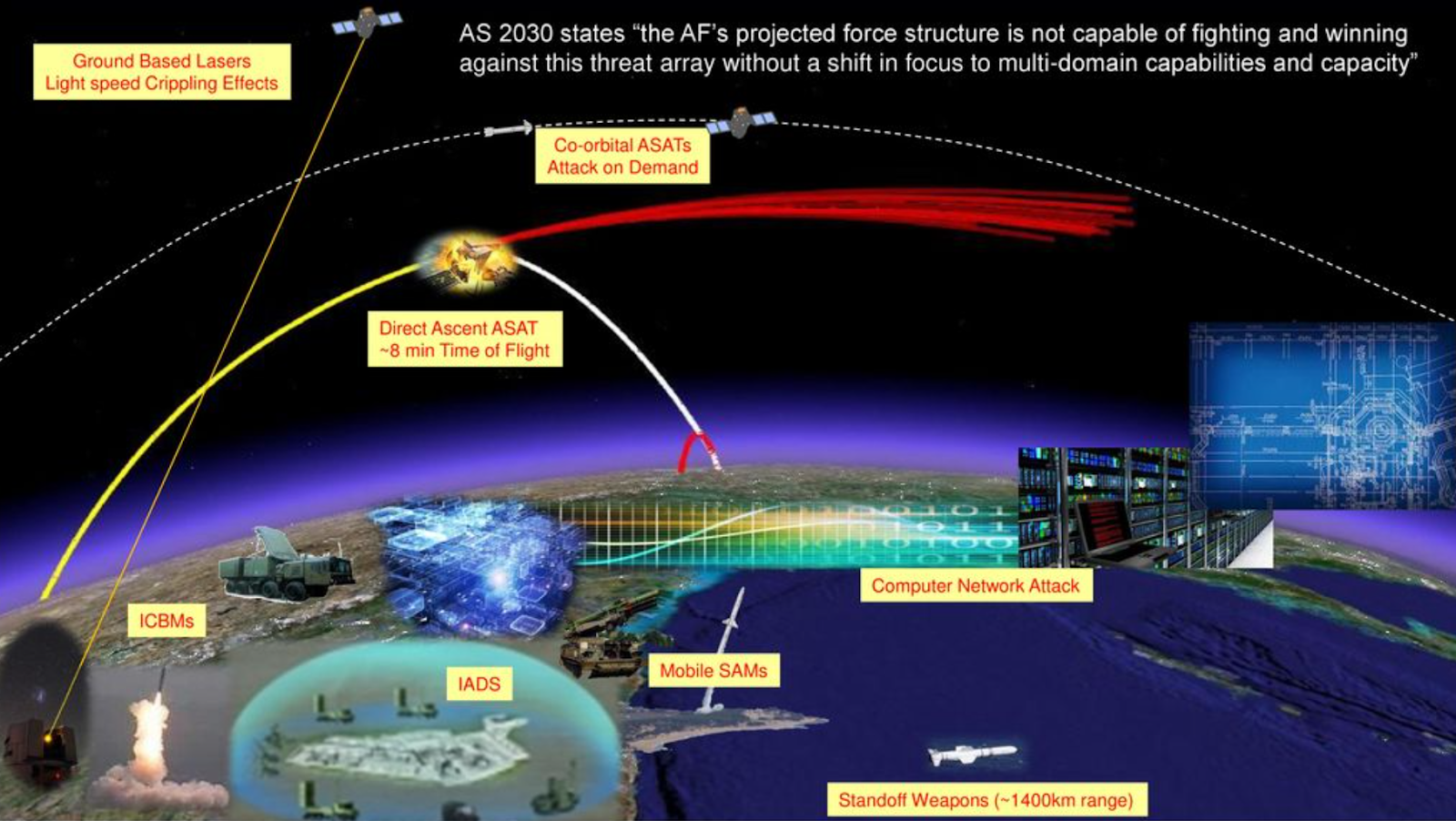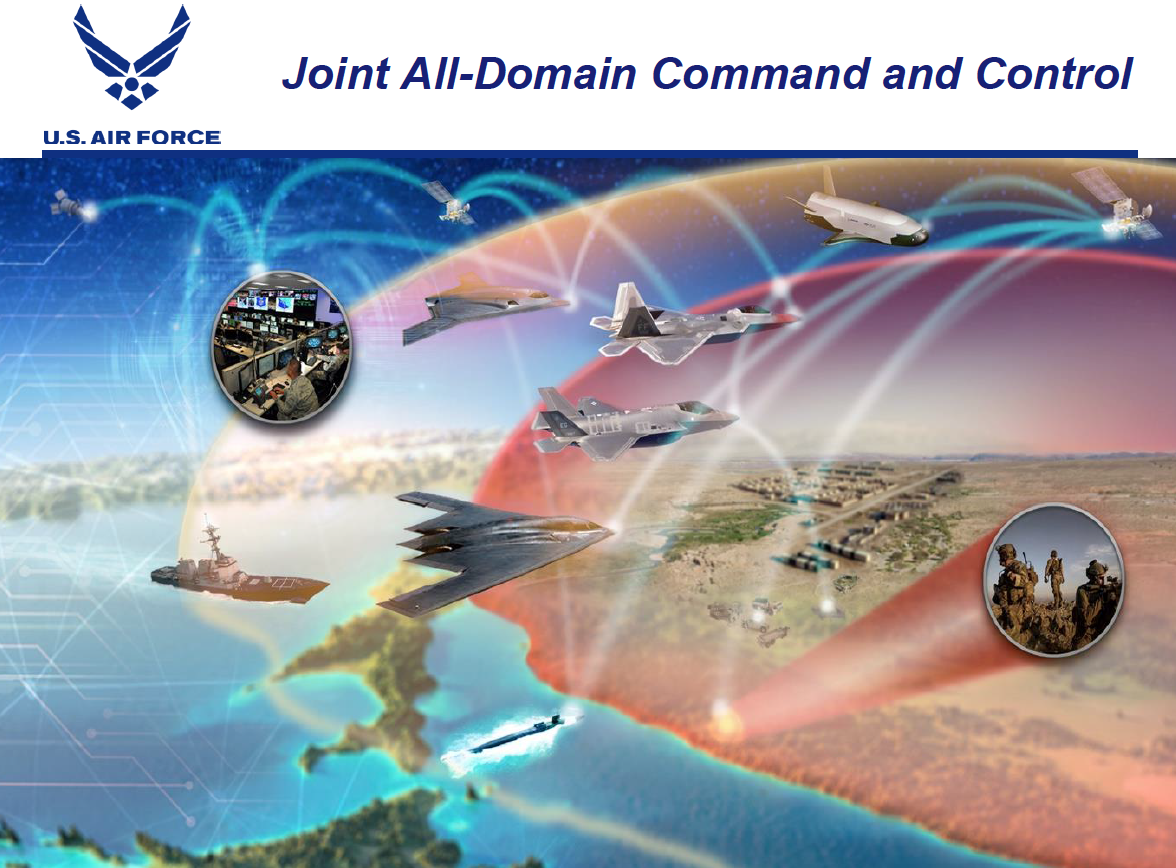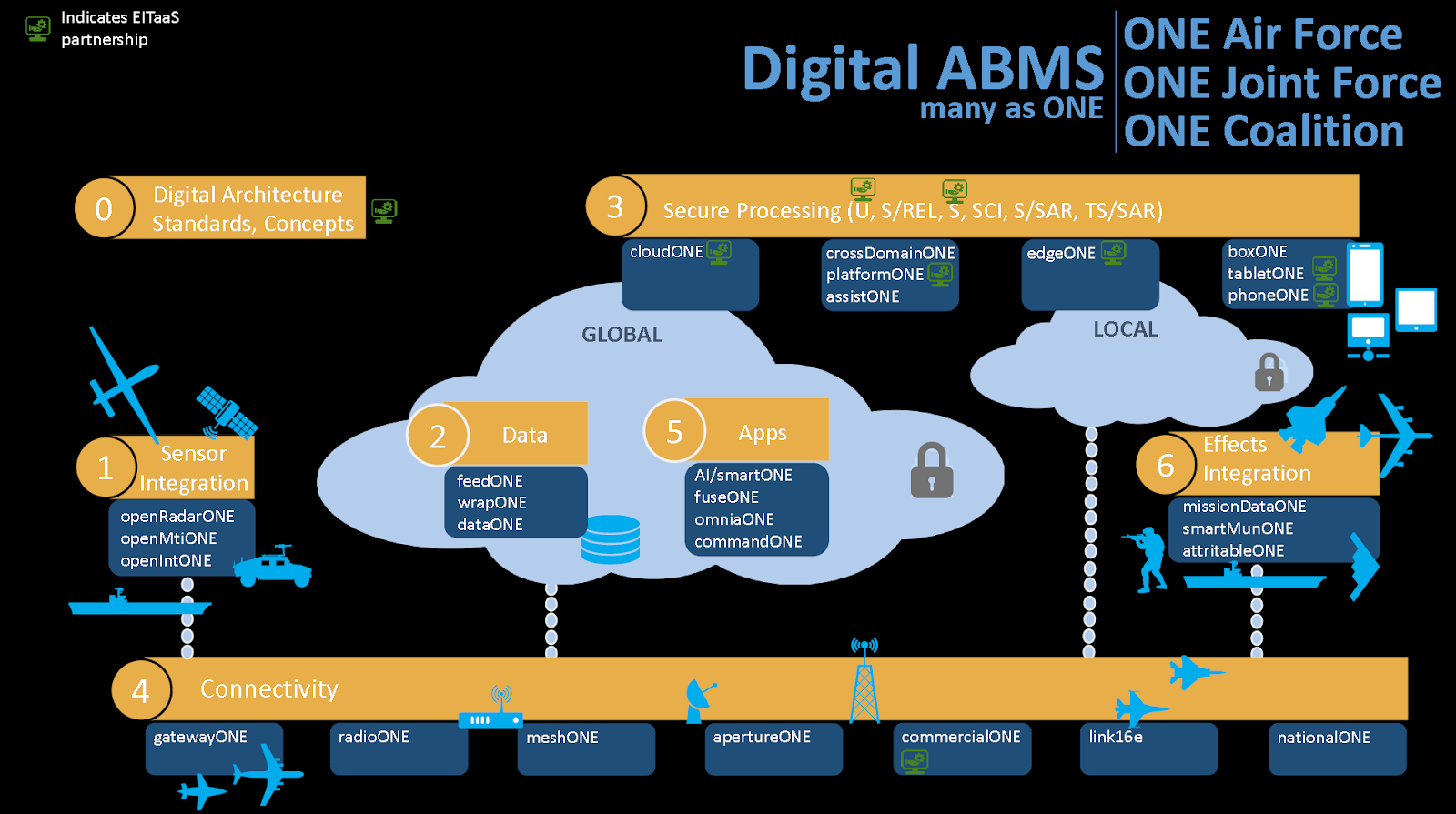8 min read
Avoiding ‘Titanium Cylinders of Excellence’ for the Joint All-Domain Command and Control JADC2 Architecture
 Rob Proctor
:
July 2, 2020
Rob Proctor
:
July 2, 2020

“We don’t call them silos, we call them cylinders of excellence, and they are made of titanium.”
— Unknown
There are some amazingly complex sensor networks and battle management systems deployed today by different branches of the U.S. Military. These systems act as the manager and orchestrator of operations in different domains. They are known as Command and Control systems (C2). C2 systems have evolved into Command, Control, Communications, Computers, Intelligence, Surveillance and Reconnaissance systems (C4ISR). Not to be outdone by a mere two or four C’s, there are now systems that have added Cyber to that mix for a total of five, heralding the arrival of C5ISR systems. I’m sure that somebody has been trying to find a way to add the terms Cooperative and/or Capability to a system name, as we all know that seven C’s are even better than five.
How does RTI Connext® DDS fit into this evolving landscape? First of all, Connext DDS is already in numerous deployed C2/C4ISR systems and has been for years, due to the natural fit of DDS capabilities for C2. At last check, we are in over 75 unique designs for C2/C4ISR battle management systems, including ground stations, comprehensive sensor networks and air superiority systems. The reasons for this are simple: DDS is an open standard, it’s easily interoperable with non DDS-based systems, it’s extensible for updates/ upgrades and it provides extensive Quality of Service (QoS) capabilities that allow these systems to get the right data from the right sensors to the right operators in real-time across several different data transports. More recently, Connext DDS Secure has become equally important, as it enforces security down to the topic level, even across several different networks.
Quick Fly-by: An Overview of Existing C2 Systems
What are the attributes of today’s most important C2 systems? It probably won’t surprise you to learn that such systems are extremely powerful and that their exact abilities have been obfuscated, because the details are by necessity classified. From a distance however, even a quick, high-level overview of the following established C2 systems can illustrate the scope and scale of what these systems are capable of:
The U.S. Army has the Integrated Air and Missile Defense (IAMD) system and its Battle Command System (IBCS). IBCS is a System of Systems approach that calls for a “restructuring of systems into components of sensors, weapons and mission command (MC), with a standard set of interfaces among those components using a standardized set of networks to communicate.” The ‘plug and fight’ architecture of IBCS provides a highly integrated next-generation air and missile defense solution for the Army. It enables “any-sensor, best-shooter” operations with a greatly expanded single integrated air picture.
The U.S. Navy is implementing the Maritime Tactical Command and Control (MTC2) system. MTC2 is a Navy C2 program that will deliver battle management aids (BMAs) to dynamically plan, direct, monitor and assess maritime operations as part of exercising C2 of Navy, joint and coalition forces in the maritime domain. Another Navy system, the Cooperative Engagement Capability (CEC), is a real-time sensor netting system that enables high-quality situational awareness and integrated fire control capability. Its goal is also “any-sensor, best-shooter” for the Navy.
The U.S. Air Force has the Joint Surveillance and Target Attack Radar System (JSTARS). JSTARS is the most successful C2 system ever flown. Part of its C2 capabilities include Force XXI Battle Command, Brigade and Below/‘Blue Force’ tracking (FBCB2/BFT), which significantly improves its ability to locate and track the movement of friendly ground forces. JSTARS was the C2 system of record for the USAF with tens-of-thousands of missions flown over decades in every major operation since Desert Storm.
There are plenty of Joint capabilities as well. The Joint Battle Command-Platform is the Army’s next-generation friendly force tracking system, equipping soldiers with a faster satellite network, secure data encryption and advanced logistics. JBC-P builds on the same FBCB2/BFT situational awareness capability as JSTARS, which is integrated across more than 120,000 platforms and is fielded or authorized to every brigade combat team in the Army.
All of these systems are exceptionally powerful and necessary for the warfighter. However, there is a foundational issue with current C2 systems that has not been addressed.

The Joint Staff and top Pentagon officials are taking charge of the armed services’ largely uncoordinated efforts to ensure truly joint operations (Source)
What is the Foundational Issue That All Current C2 Systems Share?
So, what is the key issue that C2 systems need to address? It’s not that they do not cover all domains (they don’t), it’s not even that they don’t work jointly across all branches of the military, including our coalition friends (they don’t all do that either). No, the issue is that from the start, these systems were never designed to communicate with each other, because there was never a mandate for them to do so. Each of these amazing systems were built by a different silo, walled off from other potential users. The result is that each is concerned solely with its own requirements, giving short shrift to things beyond the ‘shall statements’ in their own contracts. To be sure, these systems could be made to work together via bridges and gateways, but no one has mandated that all of these existing systems should be melded into one capability to span all domains and all branches, thus creating a true C2 system of systems. And certainly, nobody has ever mandated that these systems be ready on day one to plug in and work jointly across every branch of the DoD and across every domain.
This has been a well-known limitation for a long time, so the DoD has been working on a solution to do exactly this. The military services are now aiming to link together air, sea, land, space, cyber and information assets to better identify threats quickly using any available sensor and eliminate those threats using the best shooter. The capability to securely communicate in real-time is the linchpin in the DoD’s evolving concept for Multi-Domain Operations (MDO). The idea could lead to a revolutionary jump forward in awareness and information sharing for warfighters.

Joint All Domain C2 is focused on USAF investments and concepts of operations thinking. Image source: USAF
The One C2 Architecture to Rule Them All
In November of 2019, the DoD Joint Staff proposed a system that would commonly become known as Joint All-Domain Command and Control (JADC2). Once implemented, the theory is that every C2, C4ISR, or C7ISR (you know that it’s coming) battle management system from any branch, covering any domain, should be able to ‘plug and fight’. Depending on the mission and your role in it, you would be able to dial up a ‘profile’ of needed systems and go. But we’re a long way from this theoretical capability. Part of the current problem is that the different services have different ideas about what needs to be done to enable JADC2. Not to mention that creating a true JADC2 network, de-conflicting weapon systems and developing a truly convergent set of integrated solutions is a task of epic proportions.
Recently, one branch has become the clear favorite of the Joint Staff for JADC2. In 2018, the Air Force announced its plans to cancel its JSTARS recapitalization program and instead pursue a system-of-systems approach it called the Advanced Battle Management System (ABMS).
Instead of a one-for-one aircraft replacement for JSTARS, ABMS is envisioned to be a “family of systems,” including both hardware and software. The goal of ABMS technologies is to both contribute to and link with the yet-to-be fully fleshed out JADC2 capability. The initial 'OnRamp' test of ABMS technologies happened in December of 2019. It was planned to be the first in a series of small-scale experiments that would rapidly iterate every four months, as part of a ‘phase one’ that is set to last from now until about 2023. COVID-19 has had other plans for the second and third tests, however. The idea still remains to develop new bits and pieces of promising command and control technology that can fit together in ABMS, while adding different services capabilities to the mix - all with the goal of rounding out what could eventually be JADC2.

ABMS Construct. If you have seen any RTI presentation, this should look very familiar. They even got the color of the databus right. (Source: USAF)
According to Will Roper, the Air Force’s assistant secretary for acquisition, technology and logistics: “The technology necessary to achieve [ABMS] isn’t at all revolutionary. The great news is … this exists. We just simply have to be able to clone it and probably put a little more security in it. But it’s not unachievable.” Roper is absolutely correct. I would also add that the ABMS architecture needs to be equipped up front with the ability to apply intelligent data filtering for all participant sensors and be able to manage edge device regulation. Today, Connext DDS can help increase maximum throughput and minimize latency, while also adding the crucial element of data topic security to support this effort.
Avoiding the Silo Mentality
Currently, the Air Force has a tacit seal of approval from the Joint Chiefs of Staff for moving forward with their iterative approach. To their credit, the Air Force has invited the other services to jump on board ABMS as the foundation of a joint architecture for JADC2. In fact the main point of the first ‘OnRamp’ test was to have an Army fighter link comms with an Air Force Fighter. While the Air Force has taken the lead position via ABMS, it is not set in stone that it will eventually become JADC2. Essentially, Air Force leadership hopes that the other military services will accept ABMS as the starting point for JADC2 and will begin developing and fielding compatible technology. The other military services, however, have already publicly questioned this approach; for example, Lieutenant General Eric Wesley, Deputy Commanding General of U.S. Army Futures Command, recently noted that “ABMS cannot be the sole solution, because it doesn’t account for, in some cases, the scale or the unique requirements of all the other services.”
Unfortunately, ABMS also took a shiner recently when the Government Accountability Office (GAO) released a report criticizing the way the Air Force was handling the early stages of the system’s development. The GAO indirectly suggested that ABMS’s architects do not have a clear path forward to bring it from where it is today to a system that would trigger widespread joint force adoption. As would be expected, the Air Force has pushed back hard on that report, but it’s easy to see parallels to this effort and other good (but costly) ideas that went by the wayside because of the siloed mentality of thinking. Unless all five services adopt ABMS together, it will do little good for the Joint force, no matter how technologically advanced the system is. If ABMS wishes to succeed, it needs to be built in a way that prepares the Joint force for its eventual adoption.
Your Systems, Working as One
Fortunately, the Air Force and all services have buy-in from the DoD. On May 29th, the Air Force announced initial contracts for JADC2 technologies spread across 27 different companies. This is part of a potential $950 million in first-round contacts over the next five years to develop and enable its JADC2. The Air Force has requested $3.3 billion for ABMS over the next five years as well. JADC2 is too important of an idea to get mired down in turf wars between the different service branches and defense contractors. So what can be done now? A good place to start would be to adopt an approved Modular Open Systems Approach (MOSA) standard to create a common data communications framework.
Connext DDS is that framework. As a multi-domain system, JADC2 needs to work seamlessly across many transports: TDL, RF, TCP, UDP, Infiniband, Underwater Sensor Network Transports, lossy satellite connections, even shared memory or backplanes in a single computer. It's going to have to support multiple different MOSA standards. JADC2 has to work reliably even when those channels are disconnected, denied, intermittent, or have limited bandwidth. A common software framework is needed that can communicate across any transport while providing the fault tolerance, resiliency and security required by mission-critical applications. That framework needs to support legacy and future information models. It needs to promote modular systems that can be built and reconfigured dynamically in response to evolving threats. Common wire protocols and APIs are required for seamless integration and interoperability, breaking down the silos that have plagued current systems.
Connext DDS meets all of these needs today in a TRL-9 standards-based solution. ABMS cannot miss the mark: If it does, JADC2 might be another good idea gone by the wayside. But all agree that the JADC2 idea is of paramount importance to the DoD. One important way to not fall into a silo would be to leverage the power of Connext DDS now.
For more information, and to learn more about how Connext DDS can help with C2, ABMS and JADC2, we encourage you to visit with RTI at the NDIA Joint Armaments and Robotics Conference & Exhibition or contact us at JADC2@rti.com.
About the author
 Rob Proctor is a Lead Field Application Engineer for Real-Time Innovations. He has over 24 years of experience in A&D Embedded Software as a Software Engineer and Field Applications Engineer. Prior to his time as a Field Application Engineer, he developed and implemented real time embedded software at major Aerospace and Defense Corporations. His roles have included developing software and system designs, mission-management and display processing systems. Rob received his BS from Embry-Riddle Aeronautical University in Aerospace Studies and his MS from the University of South Florida in Engineering Management.
Rob Proctor is a Lead Field Application Engineer for Real-Time Innovations. He has over 24 years of experience in A&D Embedded Software as a Software Engineer and Field Applications Engineer. Prior to his time as a Field Application Engineer, he developed and implemented real time embedded software at major Aerospace and Defense Corporations. His roles have included developing software and system designs, mission-management and display processing systems. Rob received his BS from Embry-Riddle Aeronautical University in Aerospace Studies and his MS from the University of South Florida in Engineering Management.
Posts by Tag
- Developers/Engineer (177)
- Connext DDS Suite (77)
- Technology (74)
- News & Events (73)
- 2020 (54)
- Standards & Consortia (51)
- Aerospace & Defense (48)
- Automotive (35)
- 2023 (34)
- 2022 (29)
- IIoT (27)
- Leadership (24)
- 2024 (22)
- Cybersecurity (20)
- Healthcare (20)
- 2021 (19)
- Connectivity Technology (16)
- Military Avionics (15)
- Culture & Careers (14)
- FACE (13)
- Connext DDS Pro (10)
- JADC2 (10)
- ROS 2 (10)
- 2025 (8)
- Connext DDS Tools (7)
- Connext DDS Micro (6)
- Databus (6)
- Transportation (5)
- Case + Code (4)
- Connext DDS (4)
- Connext DDS Cert (4)
- Energy Systems (4)
- FACE Technical Standard (4)
- Oil & Gas (3)
- RTI Labs (3)
- Research (3)
- Robotics (3)
- #A&D (2)
- Connext Conference (2)
- Edge Computing (2)
- MDO (2)
- MS&T (2)
- TSN (2)
- ABMS (1)
- C4ISR (1)
- ISO 26262 (1)
- L3Harris (1)
- LabView (1)
- MathWorks (1)
- National Instruments (1)
- Simulation (1)
- Tech Talks (1)
- UAM (1)
- Videos (1)
- eVTOL (1)
 Success-Plan Services
Success-Plan Services